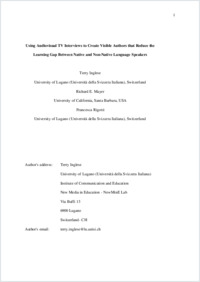Using audiovisual TV interviews to create visible authors that reduce the learning gap between native and non-native language speakers
- Terry Inglese New Media in Education Laboratory (NewMinE Lab), Facoltà di scienze della comunicazione, Università della Svizzera italiana, Svizzera
- Richard E. Mayer University of California, Santa Barbara, USA
- Francesca Rigotti Istituto Media e Giornalismo (IMeG), Facoltà di scienze della comunicazione, Università della Svizzera italiana, Svizzera
-
2007
Published in:
- Learning and Instruction. - Pergamon. - 2007, vol. 17, no. 1, p. 67-77
Multimedia learning
audiovisual TV interview
visible author
non-native language students
online learning
English
Can archives of audiovisual TV interviews be used to make authors more visible to students, and thereby reduce the learning gap between native and non-native language speakers in college classes? We examined students in a college course who learned about one scholar's ideas through watching an audiovisual TV interview (i.e., visible author format) and about another scholar's ideas through reading a formal text description (i.e., invisible author format). For the invisible author, native language speakers scored significantly higher than the non-native language speakers on a corresponding exam question (i.e., a cognitive measure), generated more words on the exam question (i.e., a motivational measure), and mentioned the author's name more often in answering the exam question (i.e., an affective measure). For the visible author, the groups did not differ on any of these measures. These findings provide evidence for the idea that making the author visible through audiovisual TV interviews can eliminate the learning gap between native and non-native language speakers.
- Language
-
- English
- Classification
- Education, teaching
- License
-
License undefined
- Open access status
- green
- Identifiers
-
- RERO DOC 7842
- DOI 10.1016/j.learninstruc.2006.11.006
- ARK ark:/12658/srd1317976
- Persistent URL
- https://n2t.net/ark:/12658/srd1317976
Statistics
Document views: 187
File downloads:
- Texte intégral: 331
